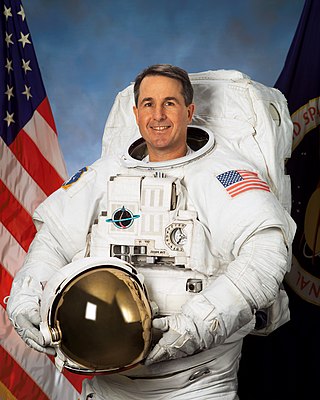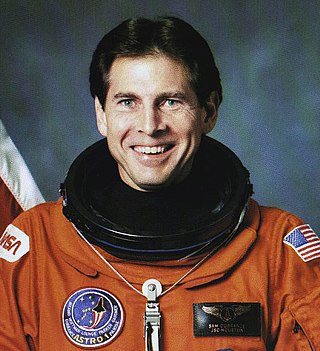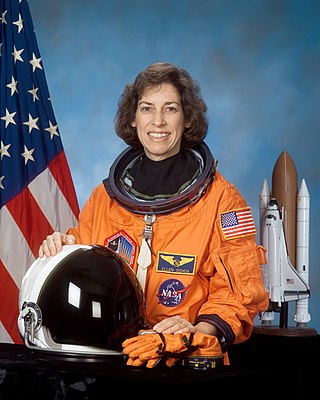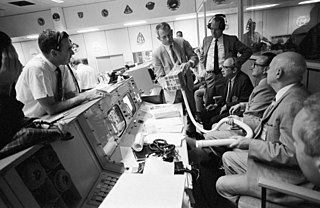Related Research Articles

Ellison Shoji Onizuka was an American astronaut, engineer, and U.S. Air Force flight test engineer from Kealakekua, Hawaii, who successfully flew into space with the Space Shuttle Discovery on STS-51-C. He died in the destruction of the Space Shuttle Challenger, on which he was serving as Mission Specialist for mission STS-51-L. Onizuka was the first Asian American and the first person of Japanese origin to reach space.

Stephen Kern Robinson is an American former NASA astronaut.

Richard James Hieb is a former NASA astronaut and a veteran of three Space Shuttle missions. He was a mission specialist on STS-39 and STS-49, and was a payload commander on STS-65. After leaving NASA he worked at AlliedSignal and Orbital before spending 14 years as an executive at Lockheed Martin. He is currently a faculty member in the University of Colorado Boulder Smead Aerospace Engineering Sciences Department.

Samuel Thornton Durrance was an American scientist who flew aboard two NASA Space Shuttle missions as a payload specialist.

Ellen Ochoa is an American engineer, former astronaut and former director of the Johnson Space Center. In 1993, Ochoa became the first Hispanic woman to go to space when she served on a nine-day mission aboard the Space Shuttle Discovery. Ochoa became director of the center upon the retirement of the previous director, Michael Coats, on December 31, 2012. She was the first Hispanic director and the second female director of Johnson Space Center.

Ronald "Ron" Michael Sega is an American former astronaut who is professor of systems engineering and Vice President for Energy and the Environment at the Colorado State University Research Foundation, a non-profit advocacy organization supporting CSU. He is also the Vice President and Enterprise Executive for Energy and Environment at Ohio State University. From August 2005 to August 2007, he served as Under Secretary of the Air Force. He is a retired major general in the United States Air Force and a former NASA astronaut. Sega was born in Cleveland, Ohio, he is of Slovene origin. He was married to fellow astronaut Bonnie J. Dunbar. He is now married to Ann Sega and they have two sons. He has lived in both Northfield, Ohio and Colorado Springs.

James Shelton Voss is a retired United States Army colonel and NASA astronaut. During his time with NASA, Voss flew in space five times on board the Space Shuttle and International Space Station. He also served as deputy of Flight Operations for the Space Station Program Mission Integration and Operations Office. While participating in ISS Expedition 2, he and Susan Helms conducted an 8-hour and 56 minute spacewalk, the longest to date.
The Colorado Center for Astrodynamics Research (CCAR) is a renowned aerospace research center specializing in orbital mechanics and spacecraft navigation, located at the University of Colorado at Boulder. CCAR was established at the University of Colorado at Boulder in the College of Engineering and Applied science during the fall of 1985 as a part of the University of Colorado's commitment to develop a program of excellence in space science and is hosted by the Department of Aerospace Engineering Sciences. CCAR is a multidisciplinary group involving faculty, staff and students from the Department of Aerospace Engineering Sciences. Its research program emphasizes astrodynamics, satellite meteorology, oceanography, geodesy, and terrestrial vegetation studies.

The A. James Clark School of Engineering is the engineering college of the University of Maryland, College Park. The school consists of fourteen buildings on the College Park campus that cover over 750,000 sq ft (70,000 m2). The school is near Washington, D.C. and Baltimore, as well as several technology-driven institutions.

Aerospace engineering is the primary field of engineering concerned with the development of aircraft and spacecraft. It has two major and overlapping branches: aeronautical engineering and astronautical engineering. Avionics engineering is similar, but deals with the electronics side of aerospace engineering.

The Purdue University School of Aeronautics and Astronautics is Purdue University's school of aerospace engineering contained within the Purdue University College of Engineering. The school offers B.S., M.S., and Ph.D. degrees in aeronautical and astronautical engineering. It also provides distance graduate education, including an online M.S. in Engineering with concentration in Aeronautics and Astronautics, and a distance Ph.D. Its main office and some of its labs are located in the Neil Armstrong Hall of Engineering. As of 2010, the School has awarded an estimated 6% of BS degrees and 7% of PhDs in aerospace engineering in the United States.

Robert David Braun is an American aerospace engineer and academic. He has served as the dean of the College of Engineering and Applied Science at the University of Colorado Boulder, the David and Andrew Lewis Professor of Space Technology at the Georgia Institute of Technology, and the NASA Chief Technologist. Currently, Dr. Braun is the Space Sector Head at the Johns Hopkins University Applied Physics Laboratory (APL).
The National Institute of Aerospace (NIA) is a non-profit research and graduate education institute headquartered in Hampton, Virginia, near NASA's Langley Research Center.

Steven Patrick Chappell is an American aerospace engineer. He is a Technical Lead & Research Specialist for Wyle Integrated Science & Engineering at NASA's Johnson Space Center (JSC) in Houston, Texas. He is helping to define and execute the research needed to optimize human performance in next-generation spacesuits and extra-vehicular activity (EVA) systems. Chappell served as an aquanaut on the NASA Extreme Environment Mission Operations 14 crew.
George Henry Born was an American aerospace engineer, Distinguished Professor, founder and Director Emeritus of the Colorado Center for Astrodynamics Research (CCAR) at the University of Colorado Boulder. He is known for his work in satellite navigation and precise orbit determination. He worked on various missions while at the Jet Propulsion Laboratory as well as navigation support for the Apollo program in the late 1960s while at Johnson Space Center.
Moriba Kemessia Jah is an American space scientist and aerospace engineer who describes himself as a "space environmentalist", specializing in orbit determination and prediction, especially as related to space situational awareness and space traffic monitoring. He is currently an associate professor of Aerospace Engineering and Engineering Mechanics at the University of Texas at Austin. Jah previously worked as a spacecraft navigator at the NASA Jet Propulsion Laboratory, where he was a navigator for the Mars Global Surveyor, Mars Odyssey, Mars Express, Mars Exploration Rover, and his last mission was the Mars Reconnaissance Orbiter. He is a Fellow of the American Astronautical Society, the Air Force Research Laboratory, the International Association for the Advancement of Space Safety and, the Royal Astronomical Society. Jah was also selected into the 10th anniversary class of TED Fellows and was named a MacArthur Fellow in 2022. He also was selected into the AIAA class of Fellows and Honorary Fellows in the year of the 50th Anniversary of Apollo 11. The AIAA "confers the distinction of Fellow upon individuals in recognition of their notable and valuable contributions to the arts, sciences or technology of aeronautics and astronautics."

Kristine Marie Larson is an American academic. She is Emeritus Professor of Aerospace Engineering at the University of Colorado Boulder. Her research considers the development of algorithms for high-precision Global Positioning System (GPS) data analysis. She was the first to demonstrate that GPS could be used to detect seismic waves. She was awarded the 2015 European Geosciences Union Christiaan Huygens Medal.
Penina Axelrad is an American aerospace engineer known for her research on satellite orbital dynamics and the Global Positioning System. She is Joseph T. Negler Professor in the Colorado Center for Astrodynamics Research and the Ann and H.J. Smead Aerospace Engineering Sciences department at the University of Colorado.
The Matthew Isakowitz Fellowship is a non-profit program in the United States that provides paid internships and executive mentorship to exceptional undergraduate and graduate students seeking careers in commercial space. The fellowship was created in memory of Matthew Isakowitz, an American aerospace engineer and early contributor to the field of commercial spaceflight who died at the age of 29.
Brian Maurice Argrow is an American aerospace engineer and Professor in the Department of Aerospace Engineering Sciences at the University of Colorado Boulder. Currently, he serves as the Chair of the department. Argrow specializes in the field of hypersonic aerodynamics, rarefied gas dynamics, dense gas dynamics, and UAVs.
References
- ↑ "History". Ann and H.J. Smead Aerospace Engineering Sciences. July 30, 2014.
- ↑ "Brian Argrow". Ann and H.J. Smead Aerospace Engineering Sciences. July 29, 2014.
- 1 2 https://public.tableau.com/shared/BFDQNT4PJ?:display_count=y&:origin=viz_share_link [ dead link ]
- ↑ "Industry Overview | Colorado Space Coalition". www.spacecolorado.org. Retrieved 2020-06-23.
- ↑ "CU Boulder's aerospace engineering program gets $15 million and a new name". 2017-01-23. Retrieved 2020-06-23.
- ↑ "CU Boulder officials gather for grand opening of aerospace building". Boulder Daily Camera. 2019-08-27. Retrieved 2020-06-23.
- ↑ "About AMReC". Aerospace Mechanics Research Center. 2016-11-07. Retrieved 2020-06-24.
- ↑ "Dr. H. Schaub - AVS Lab". hanspeterschaub.info. Retrieved 2020-06-24.
- ↑ "Laboratory". Bioastronautics. 2015-06-11. Retrieved 2020-06-24.
- ↑ "Experimental Aerodynamics Laboratory". Experimental Aerodynamics Laboratory. Retrieved 2020-06-24.
- ↑ "Research and Engineering Center for Unmanned Vehicles". Research and Engineering Center for Unmanned Vehicles. Retrieved 2020-06-24.
- ↑ "TORUS: Targeted Observations by Radars and UAS of Supercells". NOAA National Severe Storms Laboratory. Retrieved 2020-06-23.
- ↑ "Manufacturing Shops". Ann and H.J. Smead Aerospace Engineering Sciences. 2019-09-18. Retrieved 2020-06-24.